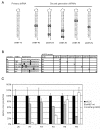A novel approach for inhibition of HIV-1 by RNA interference: counteracting viral escape with a second generation of siRNAs
- PMID: 19771206
- PMCID: PMC2737200
A novel approach for inhibition of HIV-1 by RNA interference: counteracting viral escape with a second generation of siRNAs
Abstract
RNA interference (RNAi) is an evolutionary conserved gene silencing mechanism in which small interfering RNA (siRNA) mediates the sequence specific degradation of mRNA. The recent discovery that exogenously delivered siRNA can trigger RNAi in mammalian cells raises the possibility to use this technology as a therapeutic tool against pathogenic viruses. Indeed, it has been shown that siRNAs can be used effectively to inhibit virus replication. The focus of this review is on RNA interference strategies against HIV-1 and how this new technology may be developed into a new successful therapy. One of the hallmarks of RNAi, its sequence specificity, also presents a way out for the virus, as single nucleotide substitutions in the target region can abolish the suppression. Strategies to prevent the emergence of resistant viruses have been suggested and involve the targeting of conserved sequences and the simultaneous use of multiple siRNAs, similar to current highly active antiretroviral therapy. We present an additional strategy aimed at preventing viral escape by using a second generation of siRNAs that recognize the mutated target sites.
Keywords: HIV-1; RNA interference; combinatorial therapy; gene therapy; lentiviral vector; shRNA; siRNA.
Conflict of interest statement
The authors declared no competing interests.
Figures



Similar articles
-
RNA interference as a tool for exploring HIV-1 robustness.J Mol Biol. 2011 Oct 14;413(1):84-96. doi: 10.1016/j.jmb.2011.08.035. Epub 2011 Aug 22. J Mol Biol. 2011. PMID: 21875599
-
RNA interference as an antiviral approach: targeting HIV-1.Curr Opin Mol Ther. 2004 Apr;6(2):141-5. Curr Opin Mol Ther. 2004. PMID: 15195925 Review.
-
Silencing of HIV-1 with RNA interference: a multiple shRNA approach.Mol Ther. 2006 Dec;14(6):883-92. doi: 10.1016/j.ymthe.2006.07.007. Epub 2006 Sep 7. Mol Ther. 2006. PMID: 16959541
-
Anticipating and blocking HIV-1 escape by second generation antiviral shRNAs.Retrovirology. 2010 Jun 8;7:52. doi: 10.1186/1742-4690-7-52. Retrovirology. 2010. PMID: 20529316 Free PMC article.
-
Lentiviral delivery of RNAi effectors against HIV-1.Curr Top Med Chem. 2009;9(12):1130-43. doi: 10.2174/156802609789630866. Curr Top Med Chem. 2009. PMID: 19860713 Review.
Cited by
-
Trans-inhibition of HIV-1 by a long hairpin RNA expressed within the viral genome.Retrovirology. 2007 Mar 1;4:15. doi: 10.1186/1742-4690-4-15. Retrovirology. 2007. PMID: 17331227 Free PMC article.
-
Toward a durable anti-HIV gene therapy based on RNA interference.Ann N Y Acad Sci. 2009 Sep;1175(1):3-14. doi: 10.1111/j.1749-6632.2009.04972.x. Ann N Y Acad Sci. 2009. PMID: 19796072 Free PMC article. Review.
-
Progress in the therapeutic applications of siRNAs against HIV-1.Methods Mol Biol. 2009;487:343-68. doi: 10.1007/978-1-60327-547-7_17. Methods Mol Biol. 2009. PMID: 19301656 Free PMC article. Review.
-
Inhibition of HIV-1 by multiple siRNAs expressed from a single microRNA polycistron.Nucleic Acids Res. 2008 May;36(9):2811-24. doi: 10.1093/nar/gkn109. Epub 2008 Mar 16. Nucleic Acids Res. 2008. PMID: 18346971 Free PMC article.
-
Inhibition of human immunodeficiency virus type 1 by RNA interference using long-hairpin RNA.Gene Ther. 2006 Oct;13(19):1403-13. doi: 10.1038/sj.gt.3302786. Epub 2006 May 18. Gene Ther. 2006. PMID: 16708080 Free PMC article.
References
-
- Akkina R, Banerjea A, Bai J, Anderson J, Li MJ, Rossi J. siRNAs, ribozymes and RNA decoys in modeling stem cell-based gene therapy for HIV/AIDS. Anticancer Res. 2003;23:1997–2005. - PubMed
-
- An W, Telesnitsky A. Frequency of direct repeat deletion in a human immunodeficiency virus type 1 vector during reverse transcription in human cells. Virology. 2001;286:475–482. - PubMed
-
- Anderson J, Banerjea A, Akkina R. Bispecific short hairpin siRNA constructs targeted to CD4, CXCR4, and CCR5 confer HIV-1 resistance. Oligonucleotides. 2003;13:303–312. - PubMed
-
- Banerjea A, Li MJ, Bauer G, Remling L, Lee NS, Rossi J, Akkina R. Inhibition of HIV-1 by lentiviral vector-transduced siRNAs in T lymphocytes differentiated in SCID-humice and CD34+ progenitor cell-derived macrophages. Mol Ther. 2003;8:62–71. - PubMed
LinkOut - more resources
Full Text Sources
Other Literature Sources
